Click To Go Back To The Main
To -
www.Glenstephens.com
.
November 2017
![]()



New way to detect Die 2, 3d Roos.
|
You would think
after over 100 years, that the main Dies of the Kangaroo stamps would be
clear cut in all minds. Not so. Nearly EVERY copy of the 3d
green I see offered these days as the scarce “Die 2” quite
clearly are NOT. |
”JBC” Die 1, “CA” is Die 2.
|
Show near every novice (and many dealers) a used 3d Roo stamp, and tell them it is EITHER a $15 stamp, or a $250 stamp if they squint hard enough, and long enough, - and they’ll come up with the latter identification in near all cases! |
“Fool’s Gold” Die 2s.
|
Human nature.
They are mostly wrong of course. “Fool’s Gold”. To be
fair, the difference between the two is miniscule. And in used stamps,
the area you need to look at, is often obscured by cancel ink, making it
an ever tougher guess. |
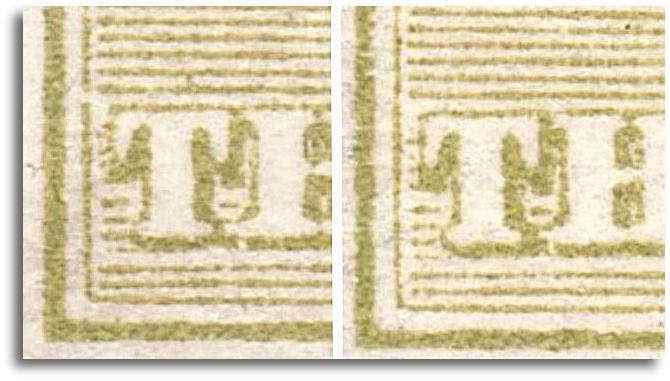
Die 1 on left, Die 2 on right.
|
Sadly,
over-inking often meant the inner frame line on Die 1 stamps is
in-filled, hence often looking like the many times scarcer Die 2. And
of course all the common Die 2B have complete inner lines,
creating another layer of confusion for Third Watermark 3d stamps. |
Simon Dunkerley quick test.
|
In his later
years, the late Simon Dunkerley posted a most helpful new “test” on
stampboards.com Simon pointed out a very simple quick visual test, that
sorted the “wheat from the chaff” in most cases. |
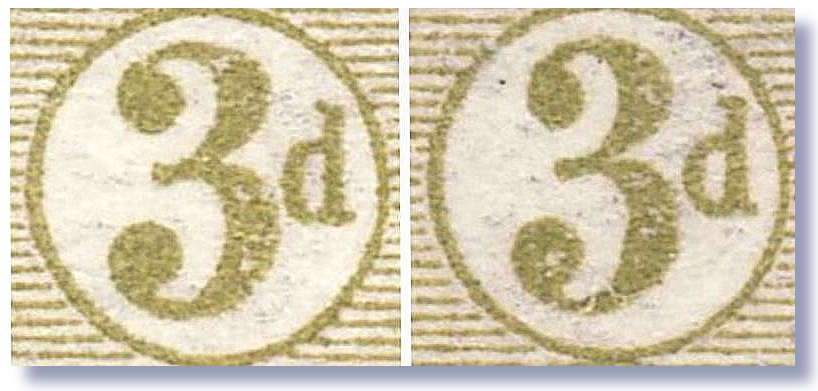
”A Watertight Die 2 Test”
|
This is a fast and ABSOLUTE test. You can see it readily with the naked eye once you keep it in mind. Tear out this page perhaps! As Simon posted at the time - “The size and shape of the top circle on the '3' has proven to be a watertight test.”Look at the fairly fuzzy Monogram stamp scans nearby from a Prestige Auction. The top blobs on the 3s can be easily picked apart. The “CA” monogram stamp is a Die 2, and the “JBC” stamp is Die 1. Easily seen - agree? |
Die 1 + 2 pairs impossible!
|
Another crazy
anomaly with this stamp is the number of “Die 1 + Die 2” horizontal
pairs that one sees offered. Again often on ebay. There is NO
such thing possible. You can have horizontal pairs of: Die 2+1, Die
2+2 or Die 1+1. |
New discovery after 90 years
|
I love my job - EVERY day is different! After 40 years
being a dealer, one still gets excited by something new or unusual
turning up in collections or offerings. This little gem shown nearby
turned up recently, after never being seen before for 90 years. |
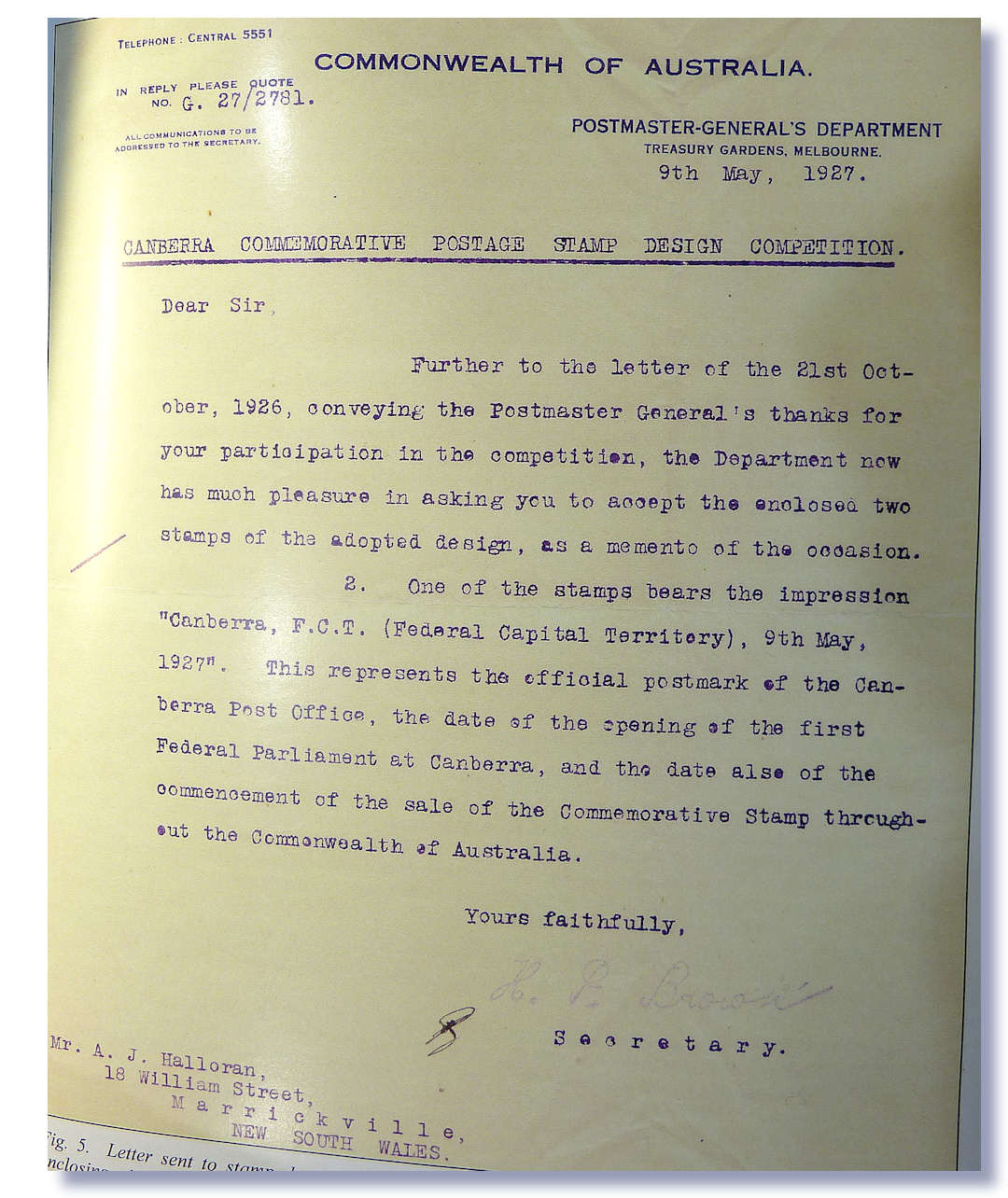
First time on the stamp market.
|
A big deal back then, as this was our FIRST ever
Commemorative stamp, in this then very new Nation. There were 1,055
submissions, including 87 from overseas countries. Very few entrants
asked for them to be returned. Hence VERY few Essays are in public
hands. |
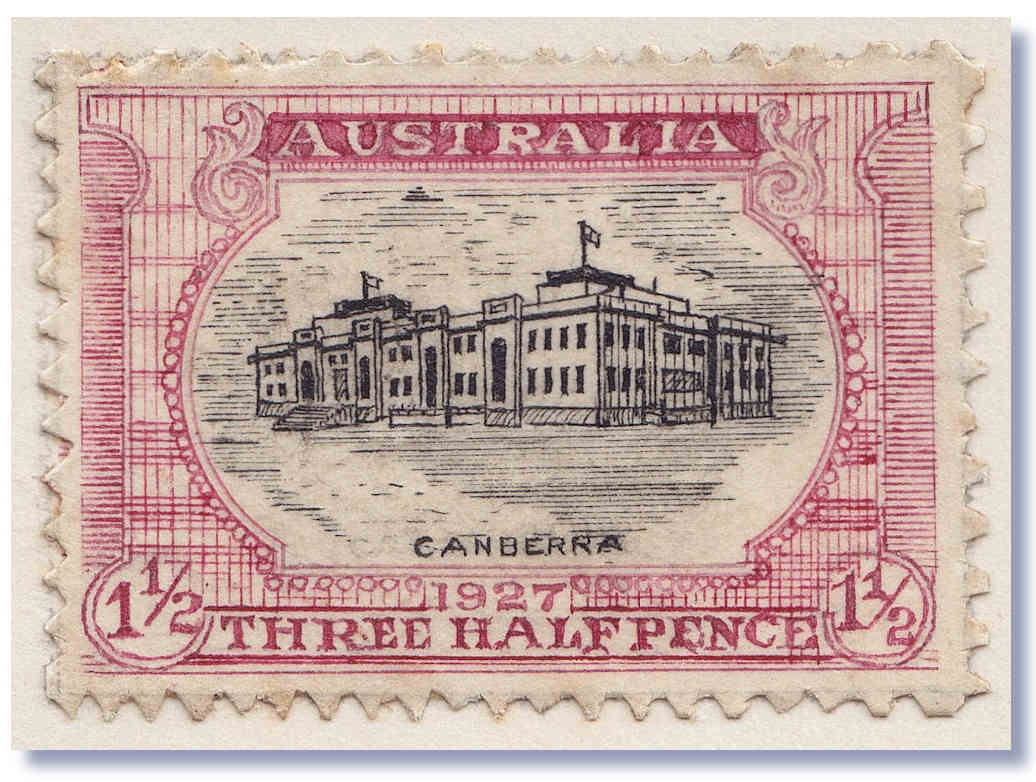
Fake ‘perfs’ added with razor blade!
|
I’ve submitted this new find for next “KGV” ACSC Edition being worked on now, and suggested it be numbered ACSC 132ES(18) - Cat $5,000. Editor Dr. Kellow kindly added it to the front cover of the September edition of the ”Australian Commonwealth Collector Club” (ACCC) journal that he is also Editor of. |
Quality of artwork varied WILDLY!
|
As it was a public competition, the artwork standard
ranged from top end grade standard - from professional designers and
trained artists, to primary school level! The really crude Essay shown
nearby on the left in Kellow handbook, looks like it was created by a 10
year old - and most likely WAS!
|
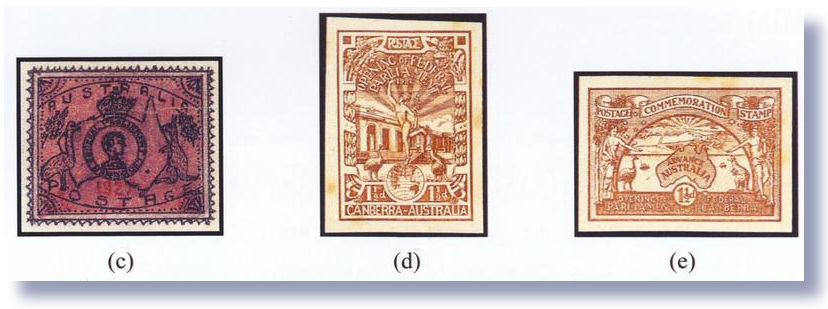
Artistic merit of entries varied a LOT!
|
Many overlook the fact this stamp was the very FIRST
Commemorative stamp from this new nation. (Indeed even Britain had never
issued Commems until the 1925/25 Wembley Exhibition issue.) All we had
were Roos and KGV heads before this, so it was a VERY big deal at the
time, in the Ozzie stamp world. |
Only 4 “non-de-plume” known.
|
The ACSC and detailed Kellow handbook records that only 4
of the 11 x 1927 Design Essays in private hands, have the artist
‘non-de-plume’ recorded - however all entries to the global design
competition needed to supply one, when submitted. |
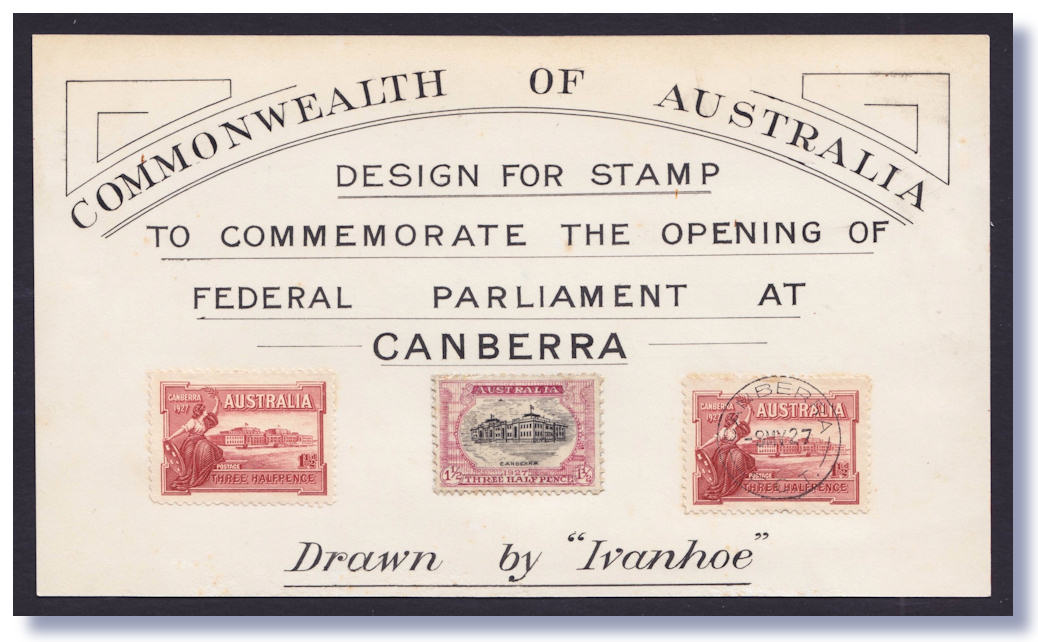
“Ivanhoe” affixed issued stamps to Art.
|
I posted this on stampboards - tinyurl.com/Ivanhoes
- and had a mini stampede of interest from leading dealers,
auctions, and serious collectors on 3 continents, and it sold in a day.
Great to see quality, and interesting, and unique material still gets
the red blood cells coursing in the hobby! |
Walter Burley Griffin founded Castlecrag.
|
The find had extra relevance to me, as Walter Burley
Griffin, who laid out and designed our new Capital City Canberra from
total rural farmland, took all his huge fees and profits from that, and
purchased another wild tract of total bush in Sydney, that he named
Castlecrag. |
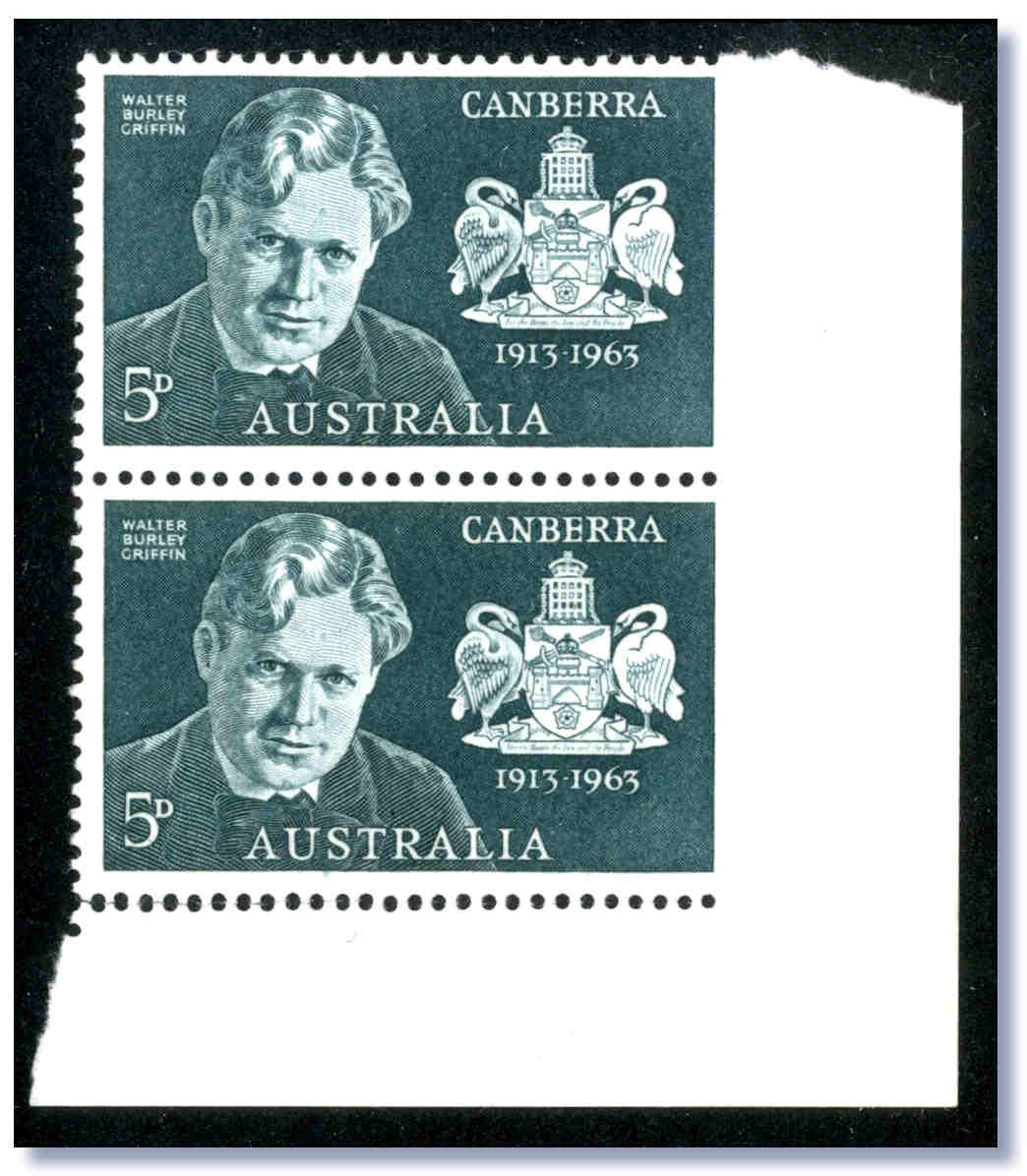
Imperf at side sold $A33,000
|
Anyway, Burley Griffin is a huge deal locally, and
when a pair of 5d Walter Burley Griffin stamps errors, imperf one side
were auctioned for $A33,000, the “North Shore Times” got
very interested. They ran a large piece on these on pages 1 and 3. The
largest suburban newspaper in NSW, probably Australia. |
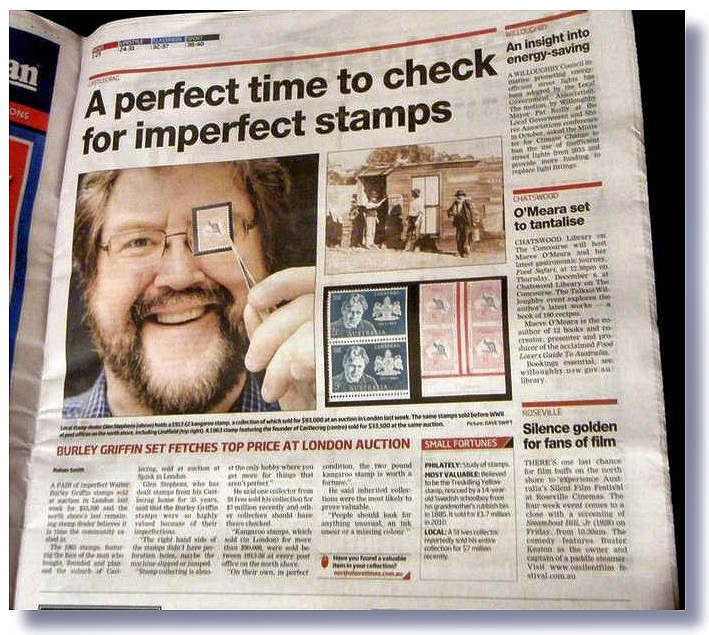
Sub-Editor cut off imperf margins!
|
The page 3 of that piece I illustrate nearby. Readers will smile wryly to notice that a “North Shore Times” sub-editor had decided to take the photo of the ERROR scan I sent them - and chopped off all the wide imperf margins off the scan, so it looked like a normal mint pair - value 20¢! |
No gum - NO problem!
|
This market is strange at times. No gum on most
Twentieth Century issues is very bad news for the sale price. For early
classics the market is far more forgiving on that, but no gum is bad
news for 1901 onwards - usually. |
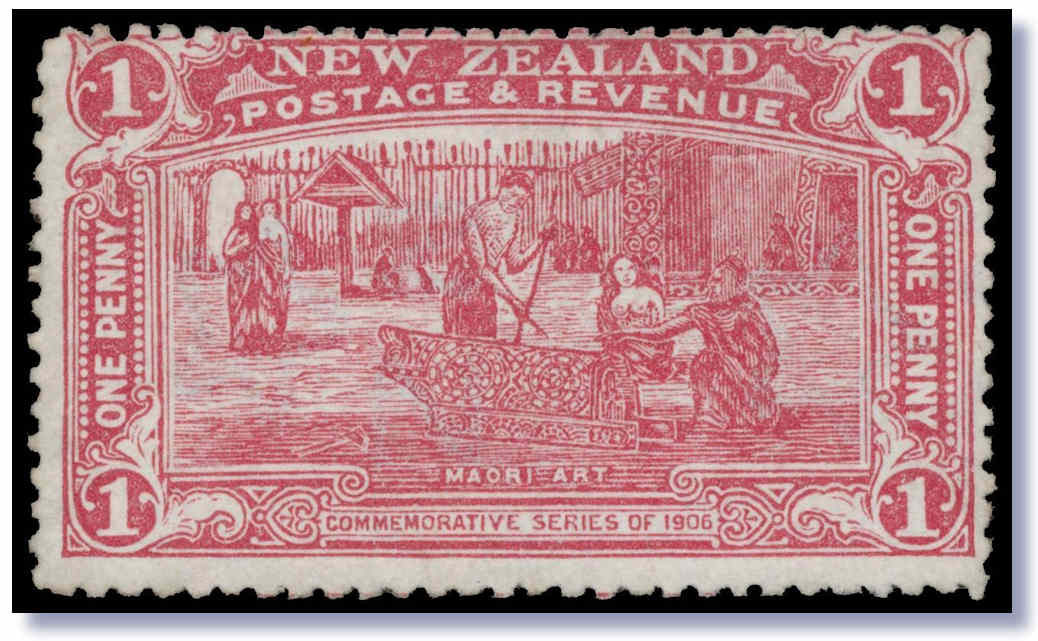
No
gum gets $A12,000.
|
Anyway, some vendor was darn happy with that very bullish price I can bet! The story of the origin of these 1d Claret stamps is worth re-telling. As all collectors know, the stamp was issued and sold in vermillion orange red, and is fairly common - SG 371 is cat £16 for mint. |
Sheet of 1d Claret purloined by Boss?
|
The Secretary of the Christchurch Exhibition, Mr E.
Righton basically purloined the sheet of “1d Clarets” that were
to have been displayed there at the Exhibition. He used many of them on
covers addressed to himself, or in his hand, and kept others mint it
seems. I know of three covers addressed to him each bearing 3 stamps
(3d) despite domestic post being just 1d. |
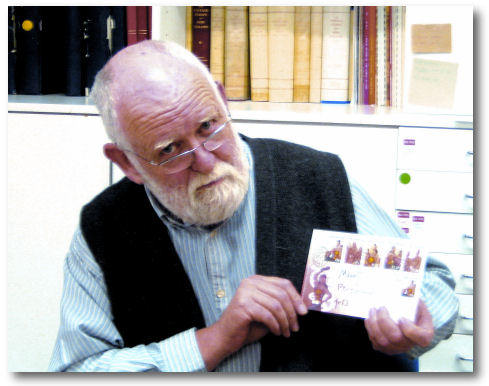
Dr Alan Craig with $25,000 NZ FDC.
|
This Dr. Craig is a senior and highly respected NZ
collector and NZ specialist, and has been on the scène there for many
decades. He was pointing out the absurdity to Warwick Patterson, that
these 1d Clarets were fully listed and priced in the CP cat, despite
none ever being on sale at any Post Office, at any time. |
I receive my first ever Maori Curse!
|
A “old school” New Zealand stamp dealer Donald Ion
was about as Maori as me I suspect, but all the same, placed a Maori
Evil Curse on me at the time, for ‘disrespectfully’ stocking
these items. I am still in perfect health 11 years on - Don sadly
passed away in 2015. |
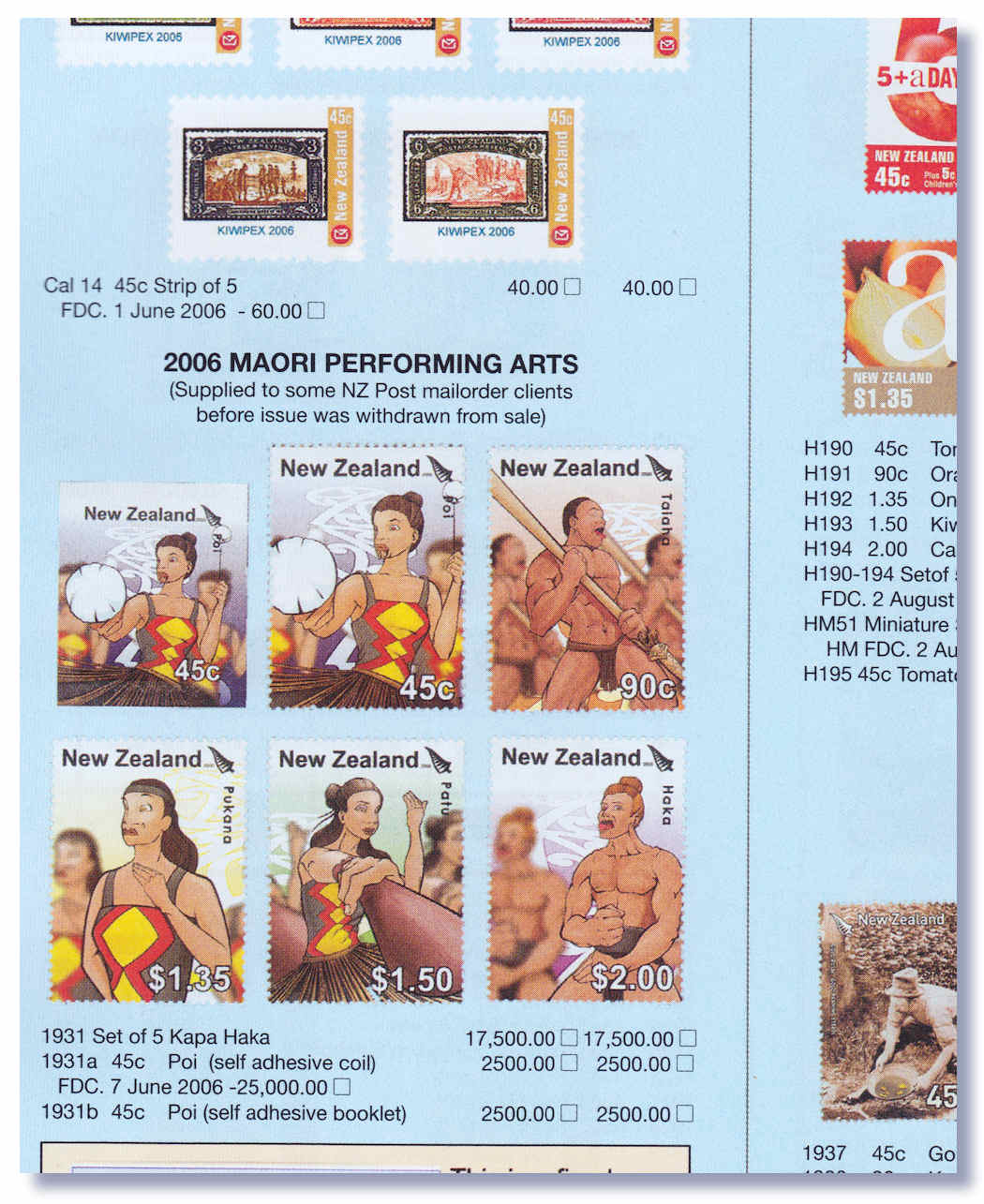
Jury cat lists at $17,500 a set 5.
|
That is weirdly how things often work over in New Zealand
- a rather closed shop. Thank goodness the very widely sold Len Jury
catalogue was more even-handed and sensible and unbiased, and now lists
them at $17,500 a set 5, FDC at $25,000, and $2,500 apiece for the
letter rate 45c coil and booklet stamps, of which about 100 each of
those were sold. |
Now added in Stanley Gibbons.
|
Stanley Gibbons recently added these into the “New
Zealand” sectional catalogue, and more and more collectors and
dealers now accept this was in fact a Post Office issued set. Largely
withdrawn at the Eleventh Hour no doubt, but a good number were mailed
and charged to those who ordered them specifically. New Zealand Post has
always agreed on this. |
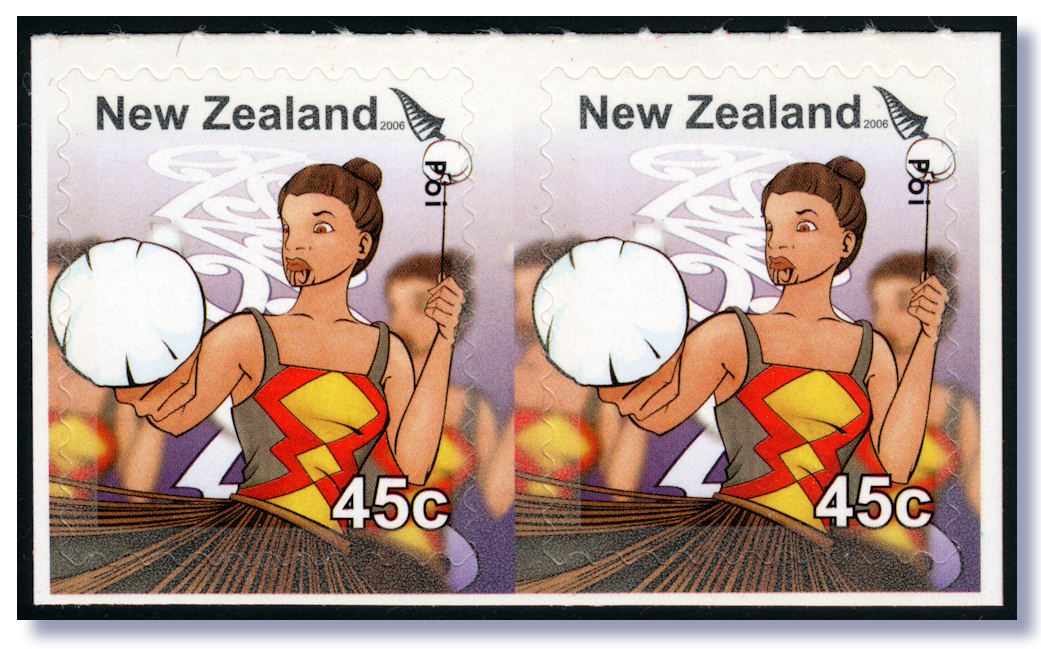
NZ 2006 “Kapa Haka” 45¢ Booklet pair.
|
I bought some sets of 5, pairs, and coil pairs and a
booklet of 10 early in the piece from some over there who were lucky to
get these as New Issues, and I still have one of each left. Some
clients who bought them early on, 11 years back have now passed, and
they mostly come back through my hands via Estates. |
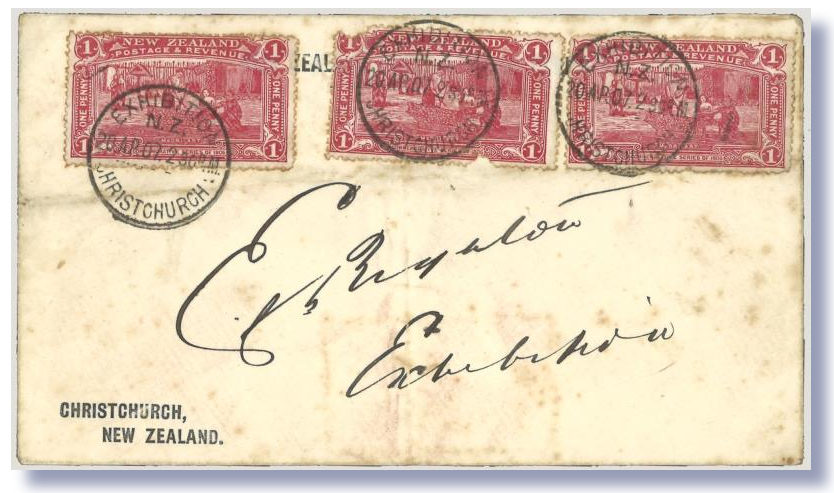
A bargain at just $80,000!
|
John Mowbray Auctions in NZ had a truly battered and gruesome looking cover with 3 “Claret” singles on it, in his October 14 auction, that looked like it had been residing on Highway 1 for a few weeks, and a mint single. |
Large CHUNKS missing from stamp.
|
The cover as you can see from the photo nearby, has large
CHUNKS missing from the central stamp which is also creased, and all are
terribly affected by foxing and toning etc. Horrible perfs and centering
too. In typical NZ cavalier style - the Auction estimate was $80,000!
|
Gibbons “Part One” Catalogue released.
|
For me the “event” of this month was the arrival of an
air freight copy of the new 2018 Stanley Gibbons “Commonwealth &
British Empire Stamps 1840-1970” catalogue. The 120th Edition
in fact. I get a tad jaded with many things in this business, but am
NOT jaded about receiving this monster each year! |
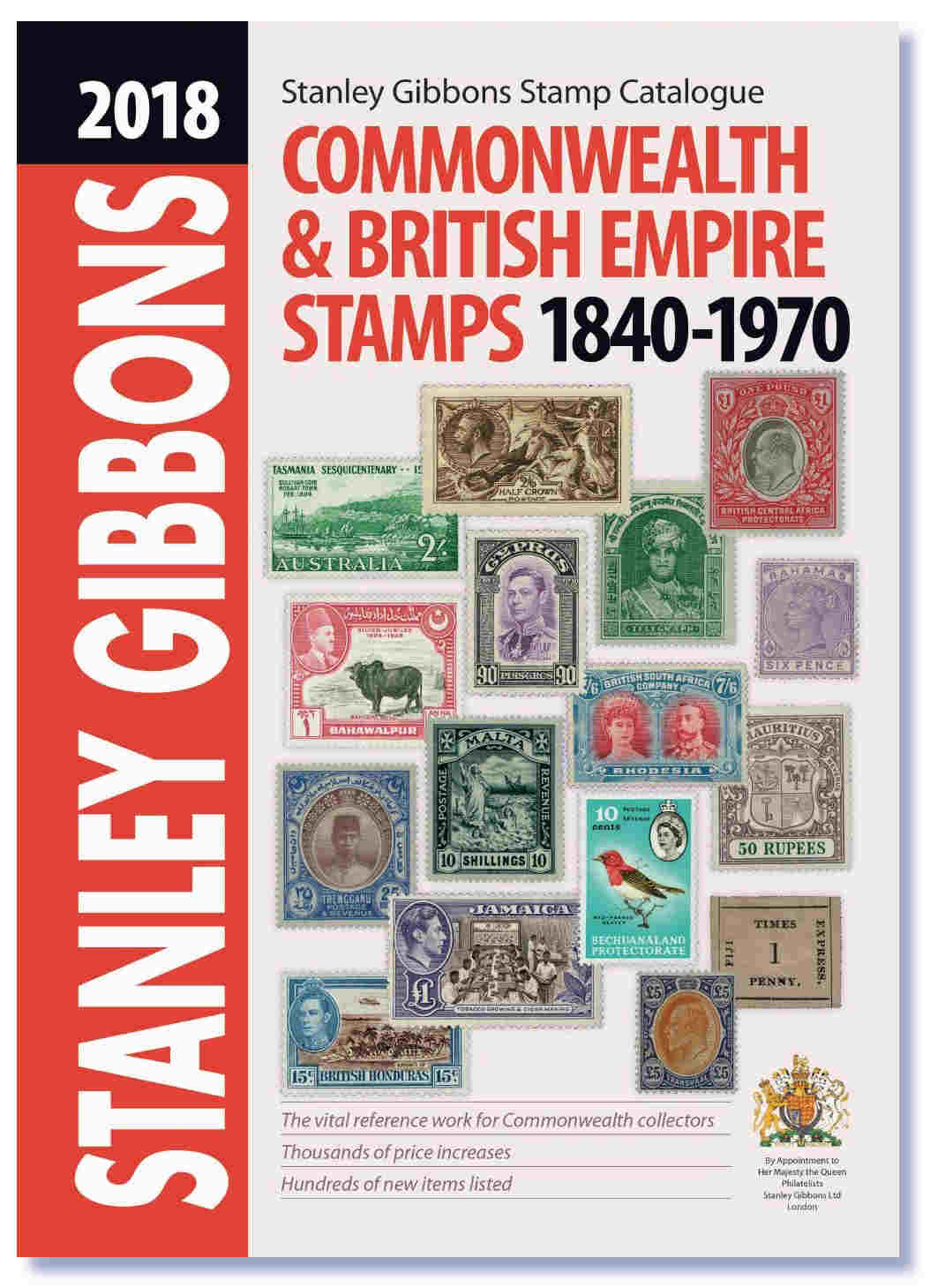
New 2018 Gibbons “Part 1” Catalogue.
|
The average
collector buys a new major catalogue only once every few years, as they
are expensive. For many dealers and collectors, being a few years out
of date is no big deal. THIS is definitely the year to update, if you
have not done so for a while! Lots of big changes and updates in here. Printed on a nice crisp fresh white paper stock. Cheery and "alive" compared to my already VERY yellowed early 2000’s SG pages, with sad grey illustrations. Colour illustrations right through, very many of them on each page. And many new varieties and listings are added this year. Near 750 huge pages now. A nice crisp clean sans serif font has been used for the last few editions, and makes it so much easier to read. And in recent editions the country headings are in RED - a very simple thing to do, and they really stand out. The small things like that are often overlooked for years! |
Colourful and vibrant SG Catalogue.
|
Lots of constant plate flaws, and booklets are now listed. And lots of inverted watermarks - for the UK all inverted and sideways watermarks are now fully listed. Find just a really medium one from a country like Australia or UK, and the entire book will be readily paid for MANY times! Often stamps cat 10p each used are cat many £1,000s each with inverted watermark. |
2d “Man With Tail” flaw ever popular.
|
Throughout the book there are new and improved
illustrations, helpful new notes on subjects as diverse as the early
lithographs of British Guiana, and the 1962 Emancipation overprints of
Tonga. There are several new watermark varieties, newly listed plate
flaws and ‘used abroads’ and many stamps, previously listed
without a price, are now given a valuation, for the first time. |
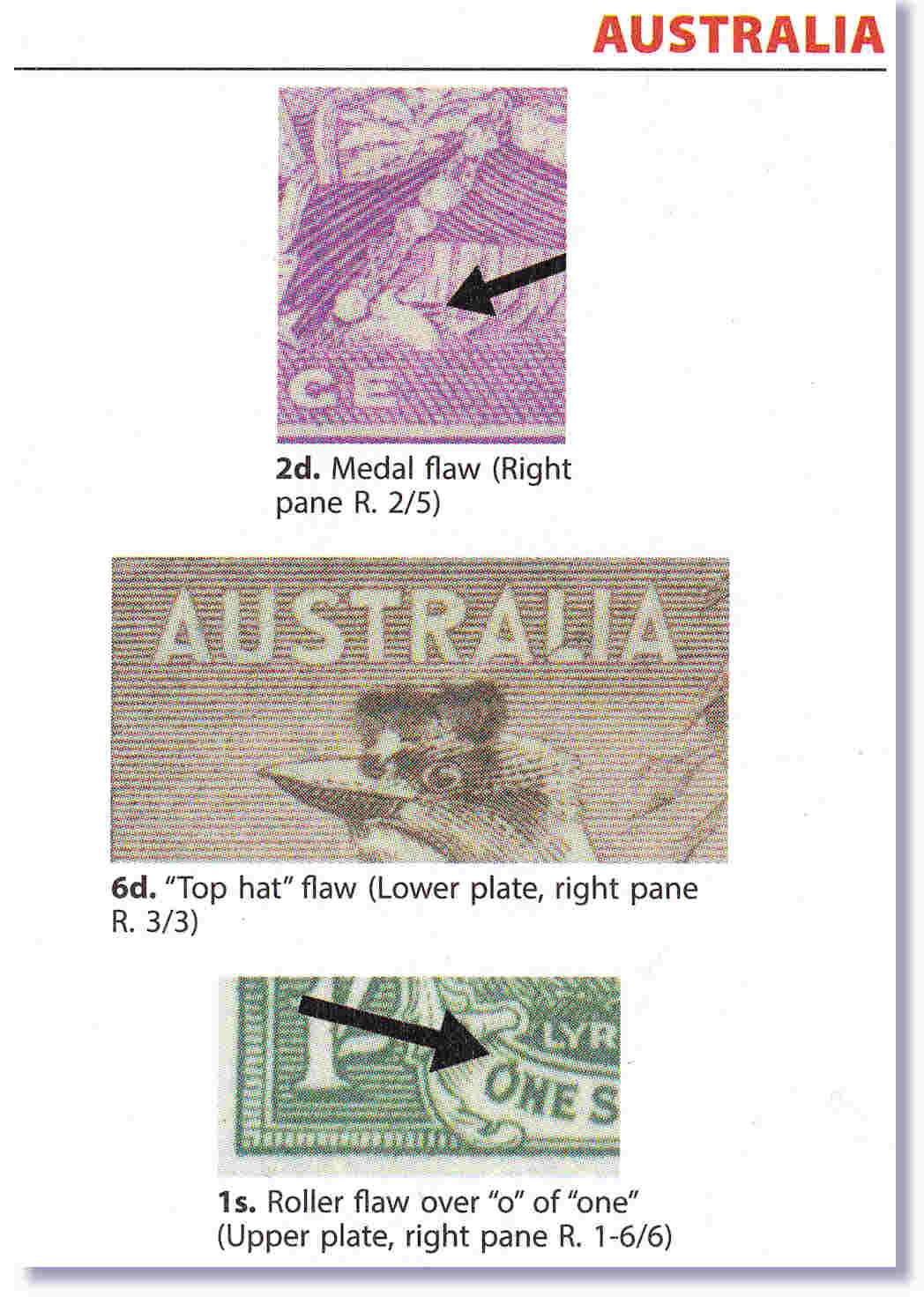
”Top Hat” to £1,400 from £550.
|
Or the “Man with Tail” on 1937 2d NSW is now £700 mint, and £140 used. I found 2 used copies in a kid's collection - those 2 alone will literally pay for this catalogue. A very, very, popular variety, as it is VERY easy to spot with the naked eye - see photo nearby. |
Ever seen a “Green Mist Retouch”?
|
Were you aware a ½d Orange Kangaroo Coil Block of 4 is
now Cat in SG at £950 mint? Or the “Green Mist Retouch” on the 1/-
Lyrebird SG 230da is £4,250 mint and £3000 used etc. “Knowledge Is
Power” - as I have probably typed here 1,000 times! |
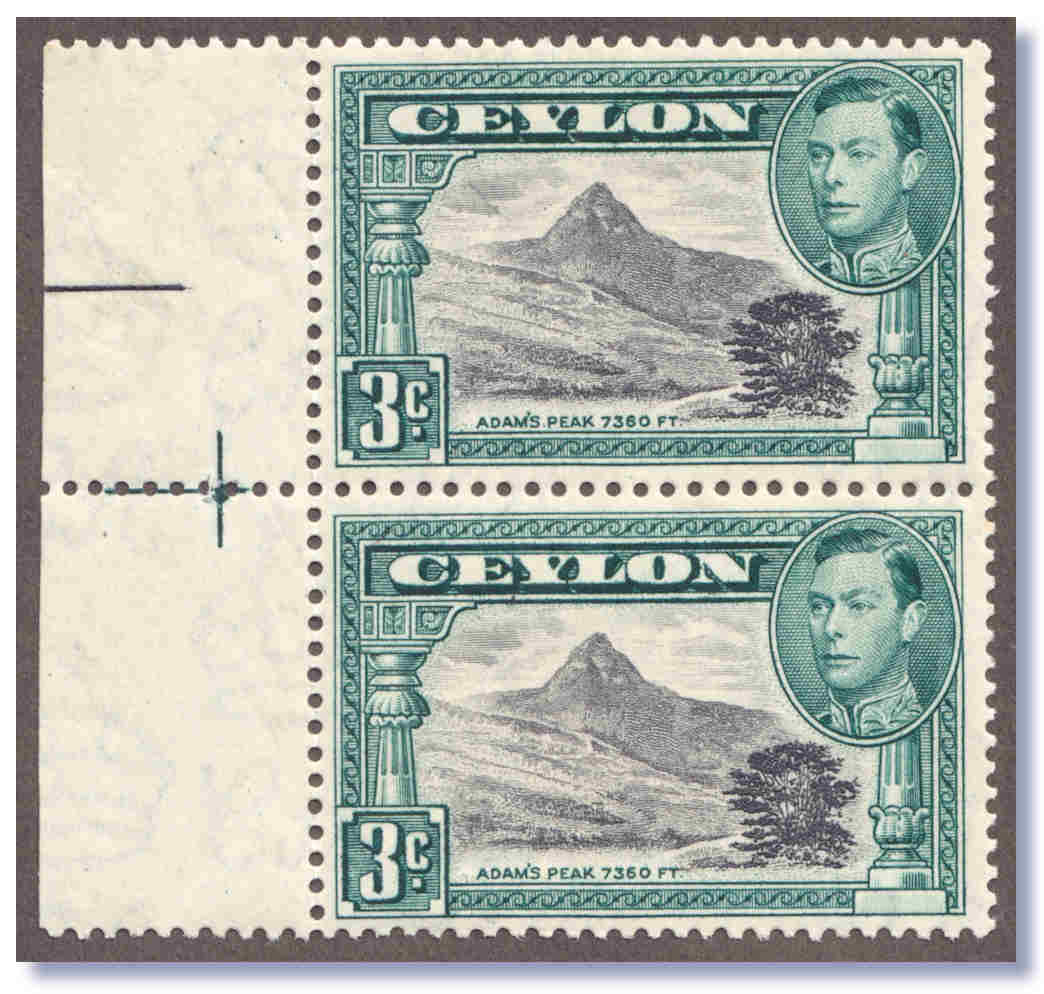
Found in junk box – sold for $350.
|
The Ceylon 3¢ KGVI MUH pair shown nearby, I found in a
junk lot, not noted as being other than a $5 pair of the lowest value of
a definitive set, as it appeared to be. I listed it on my Rarity Page
for $A350, and it sold fast, as it is cat £550. If you looked this up
in the "Stamps Of The World" you'd only see 2 cheap
stamps. |
Sold via a rowed longboat!
|
The Pitcairn Island Postmaster Roy Clark offered these to
the 2 or 3 times a year cruise boats that would anchor in deep water
offshore, as souvenirs to bored tourists - so most were lost over time
as they were very fragile, and later tossed away in the ensuing 77
years. Issued during WW2, they got no philatelic publicity, only 500
were made, and totally sold out before WW2 ended. |
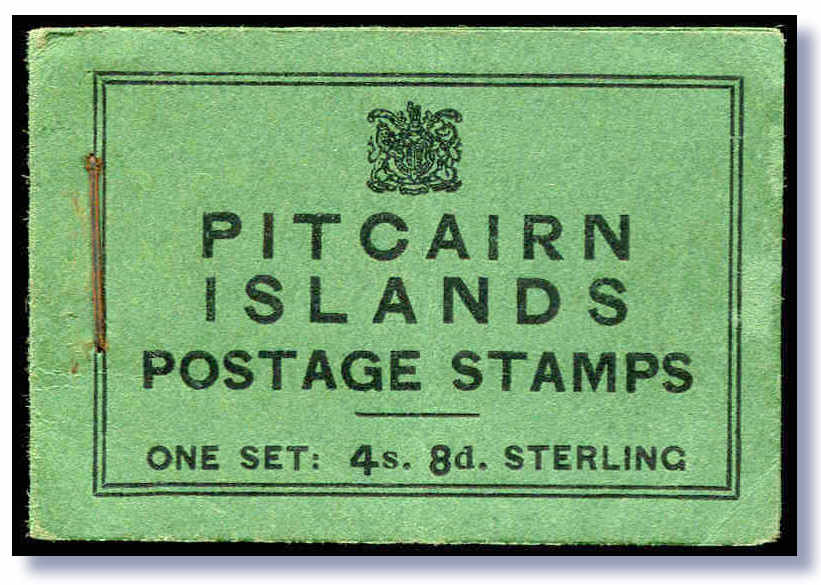
500 made, but only a few survive.
|
Collectors are famously tight fisted with catalogues, but
a strong and profitable SG catalogue division is ESSENTIAL for a
robust and healthy world stamp market. Many totally forget that, so do
your bit, and add to their sales volume. I have a “Free Global
Freight” special promo on these catalogues this month to assist! |
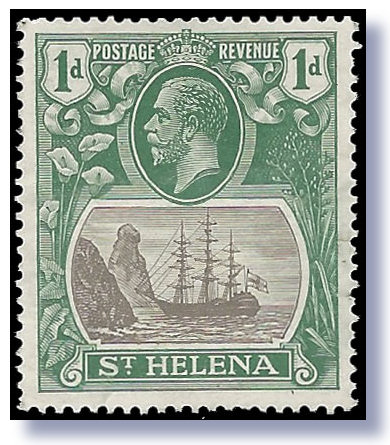
New find : St. Helena 1d Sideways Watermark.
|
The ever-popular ‘Badge’ set of St. Helena now includes
the distinctive ‘Storm over rock’ variety, as well as the
startling new discovery of the 1d stamp with sideways watermark.
This new discovery on an otherwise pretty ratty looking low value worth
$1 normally, is offered for 26,500 Swiss Francs ($A35,000) by a Swiss
dealer. |

|
|
![]()
If you would like to be notified of updates to this website,
Click HERE. If have any questions,
|
Search all my 300+ web pages! Simply type in what you are looking for. "Penny Black", "Latvia", "Imprints", "Morocco", "Fungi" "Year Books", etc! Using quotes ( " ) is more accurf used with no quotes. Search is NOT case sensitive. Tip - keep the search word singular - "Machin" yields far more matches than "Machins" etc. |
![]()
I am a Proud Member Of :

Full Time Stamp Dealer in Australia for over 35 years.
Life Member - American Stamp Dealers' Association. (New York)
Also Member of; Philatelic Traders' Society (London) IFSDA
(Switzerland) etc
![]()
|
GLEN $TEPHEN$ Full Time Stamp Dealer in Australia for 35+ years.
Life Member - American Stamp Dealers' Association. (ASDA - New York) Also Member - Philatelic Traders' Society
(PTS London) and many other philatelic bodies.
ALL Postage + Insurance is extra. Visa/BankCard/MasterCard/Amex all OK, at NO fee, even for "Lay-Bys"! All lots offered are subject to my usual Conditions of Sale, copy upon request .Sydney's
"Lothlórien", 4 The Tor Walk, CASTLECRAG (Sydney), N.S.W. 2068 AustraliaPO Box 4007, Castlecrag. NSW. 2068 E-Mail:
|
![]()
Click here to see MANY 1000s of stamp lots for sale at low $A Nett prices
Click here for all you need to know re SELLING your stamps for SPOT CASH
Click here for the current Monthly "Internet Only" special offers - CHEAP!
to read all my recent International stamp magazine articles. Click here to get back to the main www.GlenStephens.com HomepageClick here to ORDER on-line ANY items from ANY of my dozens of lists
Click for all info on Conditions Of Sale, Payments, Shipping, Returns &c
Click here for the complete library of my very unusual world travels!
How to PAY me. I accept EVERYTHING - even blankets and axes and beads!
Australia Post Annual YEAR BOOKS - massive stock - '27% off' discount offer today!
![]()
E-mail me at glen@glenstephens.com -
